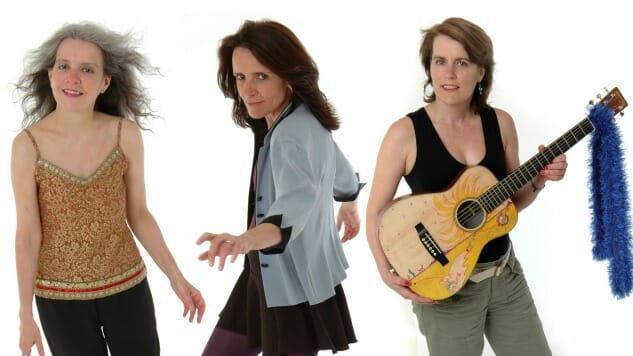Maggie Roche: The Hidden Heart of The Roches

The Roches consisted of three sisters “from deepest New Jersey,” as they once sang: two irrepressible extroverts — middle sister Terre and youngest sister Suzzy (rhymes with fuzzy) — and one extreme introvert, oldest sister Maggie. But Maggie wrote the trio’s best and deepest songs, and her low alto (“an Irish tenor,” Terre called it) was the earthbound anchor to the group’s intricate vocal mesh.
Maggie is now gone; she died Saturday of complications from breast cancer. Gone with her is the ballast that lent needed weight to the wickedly funny songs and dizzying harmonies of her two younger siblings.
“She was a private person, too sensitive and shy for this world, but brimming with life, love and talent,” Suzzy Roche wrote on the Roches’ Facebook page. Both halves of that assessment should ring true for anyone who has seen the band on stage, even truer for anyone who tried to interview them. As difficult as it was to staunch the flow of words from Terre and Suzzy, it was just as hard to pry a comment out of Maggie.
It was the peculiar chemistry of those different personalities that made The Roches such a breath of fresh air when they first emerged as a duo in 1978. In the midst of the punk/new wave/disco era, when folk music had seemingly been rendered irrelevant, this acoustic threesome with its obvious debt to Paul Simon and Joni Mitchell created songs too funny and too sad to be ignored. Terre and Suzzy could make you laugh out loud on songs such as “Mr. Sellack” (about a musician begging to get back her waitressing job) and “The Train” (about the surrealism of commuter trains), but Maggie could make you gasp for air with songs like “The Married Men” (the price of adultery) and “Quitting Time” (the price of retirement).
It helped that the sisters often seemed oblivious to how the rest of the world operated. They certainly dressed that way. At a memorable show at Washington’s Wax Museum in 1982, Maggie wore a green sequined blouse and garish housewife slacks, Terre black disco pants and a red peasant blouse and Suzzy gold-glitter basketball shoes, scarlet tights and a striped beach dress.
“People always ask us about the way we dress,” Suzzy told me then, “and I never know what they’re talking about. Sometimes I think I look perfectly normal, and people will say, ‘Oh, you’re so kooky.’ These are just the clothes I always wear. You have to admit that sneakers are the most comfortable shoes.”
Maggie translated this attitude into her 1995 song “Winter Coat.” “Can we speak a moment about the lining?” she sang, “After my own heart’s designing, it’s nylon so your skirts don’t wind up in a bunch around your behind.” She doesn’t care if it’s not stylish; she wants to sit on a train comfortably.
“A lot of people find Maggie’s song `Winter Coat’ funny,” Terre told me in 1995. “To me, though, it’s just a very careful description of how she looks at life. I thought it was so revealing. When she says she wouldn’t buy a coat because it’s hip because it’s more important that it be comfortable when she sits down on the train — that’s Maggie. Whereas I would go for the hip coat even if I had to stand up in the train.”
This oblivious attitude worked to the sisters’ advantage. When they were still teenagers, Maggie and Terre read that their hero Paul Simon was giving a songwriting class at NYU. Never mind that the class was only open to NYU students; never mind that even NYU students had to audition for the scant ten spaces (Melissa Manchester was one of the lucky ones). Maggie and Terre barged into the class and asked Simon to listen to their songs.
“He said, ‘Sure,’” Terre recalled in 1982, chuckling at her own naïveté. “So we came back, played our five songs and he said we could join the class. Then he gave us a ride up to the George Washington Bridge so we could catch our bus home. As we approached it, ‘Bridge Over Troubled Water’ came on the radio. It was so-o-o exciting. I was so nervous that when he asked my name, I couldn’t remember it.”
Simon was, in fact, so taken with the sisters that he had them sing harmony on “Was a Sunny Day” (you can see them grinning from under a floppy hat inside the album There Goes Rhymin’ Simon). Simon helped them get a publishing deal and a record contract and even produced one song on the duo’s 1975 album, Seductive Reasoning. But that’s when the fairy tale ended. Though the album was quite good, it was obvious that Columbia Records was only putting it out as a favor to Simon. The only advice the label offered was that the sisters should wear hipper clothes.
-

-

-

-

-

-

-

-

-

-

-

-

-

-

-

-

-

-

-

-

-

-

-

-

-

-

-

-

-

-

-

-

-

-

-

-

-

-

-

-








































